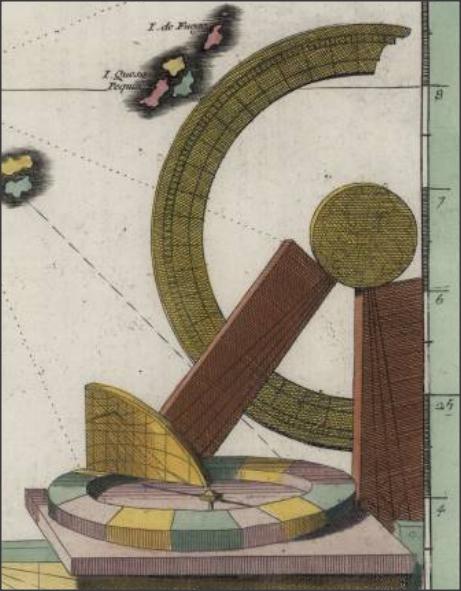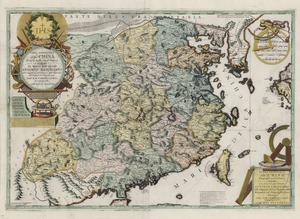
the symbol of the Jesuits

cartographic instruments
The map basically reproduces the information given by Martino Martini’s Atlas Sinensis, including Martini’s depiction of Korea and the Western part of Japan, but Coronelli adds some updated textual information, both on the map itself and at the back.
The lines of texts in the cartouche below Taiwan describe the history of the island in the seventeenth century, mentioning the Dutch occupation until 1661 and the domination of the island by Coxina (=Koxinga, Zheng Chenggong 鄭成功 [1624-1662]), which is given as still occurring, even though the island was regained by the Qing dynasty in 1683.
The lines of text in the cartouche on the left describe the demography of China and the presence of the Catholic Church there, as well the history of the Great Wall.
The text at the back of the map, titled Isole dipendenti dalla China “Islands dependent from China”, starts with a description of the country as a premise to the discussion of its surrounding islands, following the tradition of the isolarii (“Books of Islands”). The city map in the middle is misplaced, as it depicts the French harbor of Le Havre.
The geographical information provided in the text mixes names coming from Ptolemy with contemporary place names and is quite superficial. More interesting is the part dealing with Chinese religions, some of whose features are considered (following Catholic tradition) obscured remnants of a previous Christian evangelization by Saint Thomas the Apostle. Finally, the Catholic missions (especially the Jesuit ones) are discussed in some detail.
As in the previous Coronelli map dedicated to Guangdong and Fujian, what is unique is the masterful baroque blending of map, drawings, cartouches and textual information.
Sources- Caterino, Aldo (ed), Riflessi d'Oriente : l'immagine della Cina nella cartografia europea. Trento : Il Portolano ; Centro studi Martino Martini, 2008, 121-122;
- Massimo Quaini, Michele Castelnovi, Visioni del Celeste Impero. L’immagine della Cina nella cartografia occidentale, Genova, Il Portolano, 2007, 137
- Paula Findlen, “Living in the Shadow of Galileo: Antonio Baldigiani (1647-1711), a Jesuit Scientist in Seventeenth-Century Rome,” in Maria Pia Donato and Jill Kraye (eds.), Conflicting Duties: Science, Medicine, and Religion in Rome, 1550- 1750, Warburg Institute Colloquia, 15, London: The Warburg Institute and Nino Aragno Editore, 2010.
- De Ferrari, Coronelli, Dizionario Biografico degli Italiani
- http://geoweb.venezia.sbn.it//geoweb/ods/index.aspx?s=285c1718/b/&i=8143&n=309&p=9i&t=bp
- http://geoweb.venezia.sbn.it//geoweb/ods/index.aspx?s=285c1718/b/&i=8143&n=310&p=9j&t=bp
- http://geoweb.venezia.sbn.it//geoweb/ods/index.aspx?s=285c1718/b/&i=8143&n=307&p=9i&t=bp
- Translation of the two cartouches:
- Left: This kingdom of China is subdivided into 15 provinces, whose individual maps will be published (in due time). In it (=this kingdom) are scattered 155 metropolises, with 1312 cities subordinated to them, and furthermore 2357 well-fortified castles. Father Philippe Couplet of the Society of Jesus, procurator for the Chinese missions, reported that scattered (in China) are 10,128,789 families and 58,916,783 individuals. There are more than 200 temples dedicated to God and to Jesus by the zeal of that indefatigable religion (Christianity- or the Society of Jesus), 24 places of residence marked with public insignia, 3 colleges, many oratories and missionary hostels.
- Right:The island of Formosa, called by the Chinese Ta Lieukieu (i.e. Grand Lieukieu [=Da Liuqiu 大琉球]) and Belle Isle (beautiful island) by the French, whose key location is Tehouan (Taiwan), with a four-squared fortress called New Zeeland, situated in the small island which is also called Tehouan [Fort Zeelandia, Relan zhe cheng 熱蘭遮城, also known as Taiwan city Taiwan cheng 臺灣城]. There are also two other fortresses, built by the Portuguese, captured by the Dutch together with the whole island, which they kept until 1661, when they were chased away by Coxina the pirate (=Koxinga, Zheng Chenggong 鄭成功 [1624-1662]), in whose hands the island still is.
- http://en.wikipedia.org/wiki/Fort_Zeelandia_(Taiwan)


